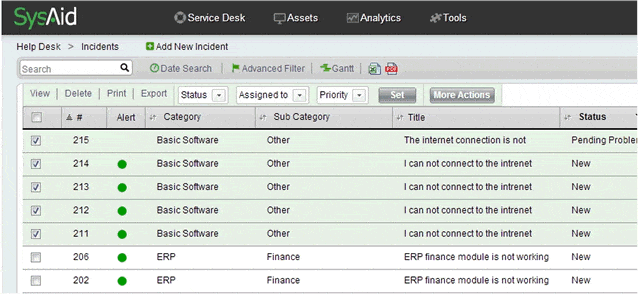Smart Ways to Dispatch Your Service Records

If you’ve ever attended one of our courses, then you must have heard the term Let SysAid Work For You. This might sound like a slogan we use in order to sell SysAid, but I promise you, it is just a description of the reality. SysAid can help reduce your response time dramatically if you implement the automation features it contains.
Let’s start from the beginning. The foundation for providing a customer with good service starts with receiving the service request or incident (service record) and dispatching it to the right group of people in the shortest amount of time. SysAid can help with this goal.
Know Your Service Desk
The first thing you need to do is research and understand your organization’s IT needs, and construct your service desk processes accordingly. This can take some time to do, but it’s worth investing the time in the long run. Start by taking two sheets of paper. On the first one write everything you are doing today, for example: what stages does a service record go through from the minute it appears in your list until someone starts working on it, what categories do you have in your service desk today and who normally handles them, etc. Look at your list and see what you would want to change. Then write down the new and improved process on the other sheet of paper.
Sometimes we do things not in the most efficient way, just because we are used to it. Be brave, and remove all your obsolete processes. Once you finish your homework, it will be clear how to proceed and start implementing some smart and automatic dispatching processes in SysAid.
Manual Can Be Semi-Automatic
If your organization has a dedicated person in the role of dispatcher for your service desk, it does not mean he/she has to go through each and every service record in order to assign it to the right person. If your service records are categorised properly (you can make sure they are, by using the End-User Portal, or the Email Rules (feature), the dispatcher can simply look at the category and description, and use the check boxes to select a batch of service records. Then, simply select the status, assigned to, and priority of the service record, and click the Set button.

If You Know It In Advance, Route… Route… Route…
If you have used routing rules before in SysAid, a question comes to mind – if we know it in advance, why not automate it? Well…you’re absolutely right, but… it is crucial you do it in a smart way. Depending on the way you run your service desk/help desk, you can choose the way you automatically route your service records. For example, if you are running a tier-based service desk, you can create a rule that will route a service record from a specific set of categories to a designated agent group called Tier 1.

Routing rules can also be determined by SLA. If you get a little creative with SysAid’s customization capabilities, you will be able to set it up so that the service record is routed differently based on the SLA and the operating hours. This way you can handle urgent service records that come in after your working hours; they can be routed automatically to your on-call team, for example. If you would like to learn how to set that up, make sure to watch the routing rules topic in the webinar recording below.
Holding Both Ends of the Stick
Most of the time in life we are forced to make choices, but don’t you just love to “hold both ends of the stick”? With our new Email Business Rules feature you can actually do that. You can set up keywords that SysAid is going to look for in an incoming email message and then route the new service record accordingly. This basically gives you a full automatic dispatching ability. For example, say you have departments that handle specific issues. You can set up a rule that will look for specific error numbers, and automatically route the service record to the right group of agents. All you need to do is go to Settings > Service Desk > Email Rules. You will find more information on how to create a rule in the Email Business Rules topic in the webinar recording below.

Webinar Recording
In February, I hosted one of our Professional Services engineer, Gil Blinov (@GilBlinov), to discuss smart ways to dispatch your service records. Check out the 20-minute recording below.
If you have any questions, please comment below or find me on Twitter at @SysAidAcademy.
Please share your thoughts in the comments or on Twitter, Google+, or Facebook where we are always listening.
Did you find this interesting?Share it with others:
Did you find this interesting? Share it with others:








